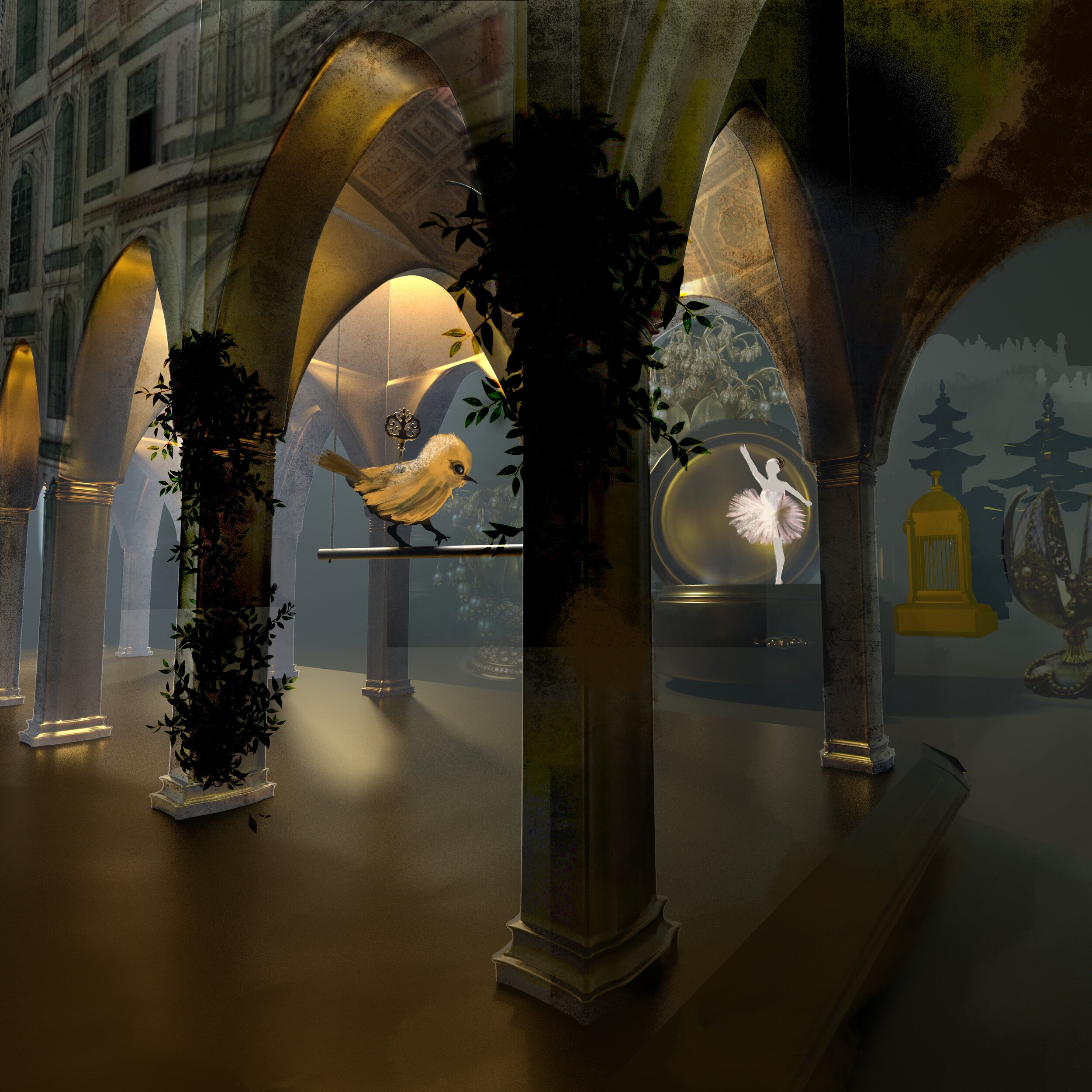
AI x The Artsphere
July 13 - 26, 2020
Arts newest medium.
On the week of 13 July 2020, we dedicated our platform to exploring AI’s evolving relationship within the art world. We spoke with leading artists, founders, AI collectives, and data scientists in the field to learn more about AI’s positive and negative potentials for art.
OUR AI COMMUNITY
Rob & Nick Carter
Rob and Nick Carter are a husband and wife artistic duo living and working in London. In 2020, they exhibited ‘Dark Factory Portraits’ at Ben Brown Fine Arts, featuring Portraits autonomously painted from photographs by an industrial robot using acrylics and brushes on a vertically-mounted support.
Ai-Da Robot
Ai-Da is the world’s first ultra-realistic AI robot artist. She can draw, and is a performance artist. As a machine, with AI capabilities, her artist persona is the artwork, along with her drawings, performance art and collaborative paintings and sculptures.
Obvious
Obvious is collective of friends, artists, and researchers, driven by a common sensibility to questions surrounding the increasing advent of Artificial Intelligence and Machine Learning. In 2018 their AI generated portrait was the first work of art to be offered by an auction house, selling at Christie’s for $432,500 — nearly 45 times its high estimate.
Visualogical
Founded by Natasha Gertler and Victoria Westerman, Visualogical is an ArtxScience curatorial collective committed to creating stimulating systems of social investigation, introspection and intervention, tackling some of the most urgent issues of our contemporary zeitgeist.
Larissa Catelano
Larissa Castellano is an Italian creative technologist. She studied Fine Arts and Information Science at Cornell University and helped develop VR film at a creative studio in London. She is interested in exploring multiple canvases and the way each medium changes the relationship between the viewer and the piece.
Teddy Favre-Gilly
Teddy is a cloud AI consultant for a FANG (Facebook, Amazon, Netflix and Google) company, working in large part with Media & Entertainment clients. He graduated from UCL in Intelligent Systems and Management, and now consults fortune 500 companies on their digital and data strategy, and works to develop emerging technologies as cloud services. In the arts world, Teddy performed as a Treble Soloist for the Royal Opera House, English National Opera and Vienna State Opera, in such roles as Miles in Britten's the Turn of the Screw, and Mozart's Magic Flute.
Sholto Douglass
Sholto has been involved with AI research in everything from robotics to protein folding at both Sydney and Tsinghua University. He’s currently interested in working out how to develop childlike curiosity in robots - so that they can learn about the world without our guidance. He’s also been involved in advising VCs on AI, and in his spare time competes internationally in Fencing.
AI Artworks
For all sale enquires please email: team@theartsphere.co.uk
‘Datapotheosis Flag’ by Till Langschied
Printed on Hahnemuhle papaer, 18,5 x 14,8 cm. Signed by the artist. Priced at £90
‘Tumaroh Tablet’ by Till Langschied
Glazed ceramic tablet, 18 x 24 x 4 cm. Edition of 5 + 2AP. Priced at £450
AI PORTFOLIO
OBVIOUS
OBVIOUS is a collective of friends, artists, and researchers, driven by a common sensibility to questions surrounding the increasing advent of Artificial Intelligence and Machine Learning. They are engaged in exploring the interface between art and artificial intelligence, and their method goes by the acronym GAN, which stands for ‘generative adversarial network’.
In October 2018 at Christies New York , the group was behind the sale of the first AI artwork to go through a major auction house. Their AI artwork titled ‘Edmond Belamy,’ sold for $432,400, nearly 45 times its high estimate, and created a frenzy surrounding AI’s role in the art world.
‘Edmond Belamy’
ANIMAL CROSSING :NEW HORIZONS
During lockdown OBVIOUS created the OBVIOUS gallery with their own artworks from ‘La Famille de Belamy’
“Using this game is a way for us to share our art and to give an escape moment for those who are stuck at home. We believe that this is an amusing and playful initiative and we encourage you to do the same and share your art!”
Hayao of the Memories Glacier (思い出の氷河の駿)
“This new magic will annihilate society as we know it. Don’t expect me to take part in it.”
MEDIUM: GANs Algorithm, Inkjet Printing on traditional Japanese Washi
SIZE: 78x106 cm
YEAR: 2019
Eikichi of the Dry Harbour (無味乾燥な港の英吉)
“This whole seemed a bit disturbing at the beginning, but I haven’t noticed any change in peoples’ appentency for partying”
MEDIUM: GANs Algorithm, Inkjet Printing on traditional Japanese Washi
SIZE: 78x106 cm
YEAR: 2019
TILL LANGSHIED
Basel-based Langschied concentrates his artistic practice on the field of human hopes and dreams and investigates how they manifest themselves in the form of machines and technologies.
In this image, Langschied is presenting the performance character Till Tumaroh.
Who is Till Tumaroh?
A fictive character who is used for live performances, videos and photography.
“He seems to have a human form, but some scientist believe that he might be an artificial intelligence that will create itself out of fragments of the Deep Web in a near future… we cannot state for sure if Tumaroh its human, android or solely an intelligent or seemingly intelligent software”
Excerpt from Memories of Tumaroh, 2018
Tumaroh will be part of a performance for a show in Vienna and will also host a palmistry workshop for the Vienna Art Week in November. The show at Kunstraum Niederösterreich: https://www.kunstraum.net/en/Exhibitions/102-stormyweather?set_language=en . After the show, Till Tumaroh will travel to Paris and perform at the Centre Culture Suisse.
CLOUDED
2019 Animated video loop, photo plot on MDF with Augmented Reality App - Video STILL
This work ‘Clouded’ combines three rings to form a cloud. The ring surfaces show source codes of Facebook, Tinder and Wikipedia. They represent the virtues of friendship, love and truth. Till’s work make’s us reflect on the transformation of humanistic value systems in a digital age.
Will we loose touch of human emotion in the age of AI?…
CIMON:
What is CIMON?
CIMON references a real robot who was sent to the ISS in 2018. The application is programmed to scan the room and place the animation of a flying robot called CIMON life into the exhibition space.
CIMON reflects the upon humans and their relationship to outer space and the technology used to get to space. These issues make us reflect on capitalism and climate change, specifically the rise of CO2 levels in the atmosphere.
‘The Ghost Machine that is my house’ 2020 by Till Langschied
This sinister house with flickering lights makes us question the safety of Cyber Security and AI. A voice describes how this smart home has been taken over by hackers, Amazon workers and computer bugs. The inhabitants have no control over their devices or life whilst living in this controlled machine disguised as a home.
MEET OUR AI RESEARCHERS & CONSULTANTS
SHOLTO DOUGLAS
Sholto has been involved with AI research in everything from robotics to protein folding at both Sydney and Tsinghua University. He’s currently interested in working out how to develop childlike curiosity in robots - so that they can learn about the world without our guidance. He’s also been involved in advising VCs on AI, and in his spare time competes internationally in Fencing.
EDOUARD (TEDDY) FAVRE - GILLY
Teddy is a cloud AI consultant for a FANG (Facebook, Amazon, Netflix and Google) company, working in large part with Media & Entertainment clients. He graduated from UCL in Intelligent Systems and Management, and now consults fortune 500 companies on their digital and data strategy, and works to develop emerging technologies as cloud services. In the arts world, Teddy performed as a Treble Soloist for the Royal Opera House, English National Opera and Vienna State Opera, in such roles as Miles in Britten's the Turn of the Screw, and Mozart's Magic Flute.
ROBBIE WYNESS
Robbie is a Masters student at Goldsmiths University of London. His current thesis seeks to examine the potential political implications of AI Art.
Herbert Marcuse
In Robbie’s IGTV video, he talks about one of his role models - German American philosopher, sociologist and political theorist Herbert Marcuse (1898-1979)
“Herbert Marcuse and many of his contemporaries paid a lot of attention to the inevitable symbiosis of technology and art, of course in a very different context to the one we see today. But the things I like the most are the ones with a feeling of prophecy, no matter how old or new. My favourite works of art or theory - or both, as they so often ca be - are the ones that feel like they speak to now, whenever now might be, because they speak to that paradoxical constant that everything is always about to change”
If you would like to learn more about Artificial Intelligence- AI Cloud consultant Teddy, recommends ‘AI Super Powers: China, Silicon Valley and The New World Order’ by Kai-Fu Lee.
“It is a great recount of the progress in AI in the past 5- 10 years, and a great comparison of the America versus Chinese innovation culture” Teddy
Pictured here is a DeepDream image of Dali’s ‘The Persistence of Memory’ (1931). The Artsphere’s AI ‘Mover & Shaker’ Sholto Douglas, a Sydney-based AI researcher and advisor, finds inspiration in DeepDream — a computer vision program created by Google engineer Alexander Mordvintsev which uses a convolutional neural network to find and enhance patterns in images via algorithmic pareidolia, thus creating a dream-like hallucinogenic appearance in the deliberately over-processed images.
VISUALOGICAL
Founded by Natasha Gertler and Victoria Westerman, Visualogical is a female-founded ArtScience curatorial collective committed to creating stimulating systems of social investigation, introspection and intervention, tackling some of the most urgent issues of our contemporary zeitgeist.
Natasha Gertler uses her Physics degree; MSci in Science Communication from Imperial College London; and curatorial training from Goldsmiths to inform her continued exploration of the intersection between art, technology and society. She has curated interdisciplinary exhibitions and experiences at the Science Museum, the Courtauld Gallery, Whitechapel Gallery and beyond.
Victoria Westerman uses her MA in Art and Science from Central Saint Martins and her background as a visual researcher and instigator of community art workshops to design experiences of enhanced communication and engagement, seeking to dismantle the boundaries between audience, research and future realities. She has collaborated with the likes of CERN, Cambridge University, and Tate Modern.
Stemming from the success of the ‘Psyche-Selfie’ lab at Artsy’s @artnightldn in 2018, Visualogical’s most recent commission is for the @museumofthehome in Hackney, and is their largest showcase of AI art yet.
The Museum of the Home, which is formerly known as the Geffrye Museum, has been closed for the past 2 years undergoing a huge transformation and redevelopment project. During this project, they have built a brand new contemporary gallery which aims to explore what home means in today’s world.
Visualogical has been commissioned to create the inaugural show for this new gallery and they have used this opportunity to explore the relationship between home and mental health — which is now more important than ever in this era of collective isolation.
Their exhibition is called ‘Happy Place,’ and uses this well-known concept of the safe space that you go to in your mind during times of stress or anxiety as an entry point to explore themes of mental health and home.
They have collaborated with @birkbeckuol to develop an interactive digital art making programme that uses AI to enable participants to take snapshots of their conceptual Happy Place. They call these snapshots “Psyche-Selfies,” as they are artistic interpretations of people's subconscious sanctuaries, and they are created by a series of mind-mapping exercises and questions about domestic happiness. Each Psyche-Selfie is a personalised artwork that the participant has created in collaboration with the AI algorithms - very limited edition of 1 (!) as no two Psyche-Selfies will be the same.
Once a significant number of Psyche-Selfies have been collected, Visualogical will look for visual patterns in these artworks to try and identify common themes and provide insight into the collective Happy Place. This data will then be given to the relevant charities and councils in the hopes of providing better insight into how to make people’s homes happier places.
The exhibition will hopefully open this autumn, all being well, but Visualogical is launching an online version earlier this summer, so stay tuned!
TECHNO-SHAMANISM
TECHNO - SHAMANISM :
A CULTURAL MOVEMENT THAT SEEKS TO BRING THE HUMAN SPIRIT TO THE OFTEN VOID DIGITAL REALM
“Technoshamanism encourages using the most advanced of available tools to understand the individual and humanity as a whole. AI is a wonderful symbol of encountering a new consciousness into our lives and learning not only how to utilise it for our current society but also encourages discourse on bringing a new form of life into the world. That's why any projects we do that include AI will always be vessels for good and making humanity a more human experience.”
Visualogical identify as practitioners of Techno-shamanism, which is a cultural movement that seeks to bring the human spirit to the often void digital realm. There are many terms for spiritual movements within digital technology such as cyberpaganism, digital occultism, cyber-wiccan, digital spirituality, all of which embrace ancient practice with more modern tools to enhance practice. The term extends upon the meaning of shamanism; the ancient practice of enhancing one's consciousness to access information concerning the inner and outer worlds by using tools such as ritual, psychoactive substances and meditation to reach these altered states.
Techno-shamanism uses the modern tools of the 21st century to enhance inner and outer reflections of reality; in this case using digital art to shift consciousness. A mirrored approach is not just to bring technology into the practice of shamanism but to bring the principle of shamanism and spiritual growth into the construction of digital culture. This ensures that digital spaces are designed to be healthy and accessible to humans and offer the space to grow as individuals and a society as a whole.
SARAH SELBY & KRISTIAN JONES
Sarah & Kristian are an interdisciplinary artist duo who joined force during lockdown to explore digital culture through creative applications of emerging and pervasive technologies.
‘VIRUS’
In this ongoing project, Sarah Selby and Kristian Jones are using AI to generate a ‘virus’ using collective emotion data taken from twitter posts.
This work explores the relationship and parallels between the current pandemic and surveillance capitalism. The term ‘surveillance capitalism’, coined by Suzanna Zuboff, describes the commodification of our behaviour surplus generated through digital interactions. As we become increasingly reliant on virtual platforms, we are generating an unprecedented amount of data - the fuel of surveillance capitalism. In this piece, the virtual virus is fed with tweets surrounding the pandemic - mutating and evolving in response to the collective public emotion.
AI generated covid selfies with Runway
“In a fast moving world, pause before you buy into anything. Question the purpose behind each movement.”
How does digital culture contribute to the development and implementation of new and pervasive technologies? How many of our online trends can be explained by emergent social phenomena, and how many have much more orchestrated origins?
Reflecting on the emergence of the #selfie trend into popular culture in the early 2010’s, @sarahselbyart and @_kristianjones have been tracing the development of front facing phone cameras, filters, trending topics and facial recognition. As artists, they know that no element of a good artwork is accidental. Every stroke, marking or decision they make is a considered choice. The design of technology is no different. Each aspect is meticulously designed to curate environments and trigger actions that serve a purpose.
Since the beginning of the pandemic, we have seen facial recognition companies scrambling to improve their algorithms to overcome issues created by face masks. To create this artwork, they utilised the same processes to visualise the vast amounts of pre-labelled images companies can access, and how quickly they can be used to improve their systems. They scraped instagram for trending hashtags such as #covidselfie and #coronafashion, building a dataset of 10,000 images. They then used StyleGAN to generate artificial images of people wearing masks (with surprising accuracy!)
‘Raised by Google’ by Sarah Selby
‘Raised by Google’ by Sarah Selby explores the impacts of current data practices on our seemingly autonomous lives, investigating to what degree our opportunities and experiences are influenced by the underlying systems of a data-driven society.
Exploring the rapidly expanding behavioural futures market highlighted by Shoshana Zuboff in her book ‘The Age of Surveillance Capitalism’, the exhibition circumvents the opacity inherent to these practices by placing the viewer within the mechanisms of ‘black box’ algorithms that underpin our daily lives. The show adopts processes and techniques prominent in the behavioural analytics industries such as psychographic analysis, microtargeting and the gamification of data collection. Psychographic microtargeting is a method of citizen profiling that goes beyond previous demographic segmentation by dividing groups into narrower subsets based on attitudes, interests, moods and dispositions. This level of extreme microtargeting has been made possible by large available amounts of big data, the availability of targeted media platforms such as social media, and advances in experimental methodology such as artificial intelligence and machine learning.
Raised by Google was developed with the support of The University of Cambridge Psychometrics department and utilises their software ‘Apply Magic Sauce’ to analyse visitor data.
ROB & NICK CARTER
In February, London based husband and wife duo Rob & Nick Carter held ‘Dark Factory Portraits’ at Ben Brown Fine Arts. They worked with a robot arm to examine whether a machine can become an artist. The exhibition featured a series of AI portraits of iconic artists including; Andy Warhol, Frida Kahlo, Jean- Michel Basquiat and Yoko Ono.
DARK FACTORY PORTRAITS




“Without a doubt AI and Machine Learning will have a huge impact on the future of art and the working world in ways that we cannot begin to dream or imagine”
Rob & Nick Carter
LARISSA CASTELLANO
Larissa Castellano is an Italian creative technologist. She studied Fine arts and Information Science at Cornell university and subsequently worked for a creative studio in London where she helped develop a VR film. Larissa is interested in exploring multiple canvases and the way each medium changes the relationship between the viewer and the piece.
Carousel “Going through the motions”
During lockdown we were all confined to the spaces of our home which made us reflect on our routine and everyday life. Larissa wanted to convey that routine can sometimes be like a cage. She thought of music boxes which work with a pattern and structure similar to the concept of routine. She therefore made a landscape composed of many music boxes set in a surreal landscape with birds and cages.
For Larissa the perception of a music box related to how she felt during lockdown. However, this experience was different for all of us. Her work will make you question and reflect on what lockdown meant for each of us. Will we go back to our old habits or not?
Preparatory sketches for Carousel
UPSIDE DOWN
“I am using 3D to create fictional landscapes where no rules apply. A vast land of emptiness and the occasional lantern or floating jellyfish. Are we underwater or are we in a desert?”
Larissa imagines this work to be part of a potential VR Experience.



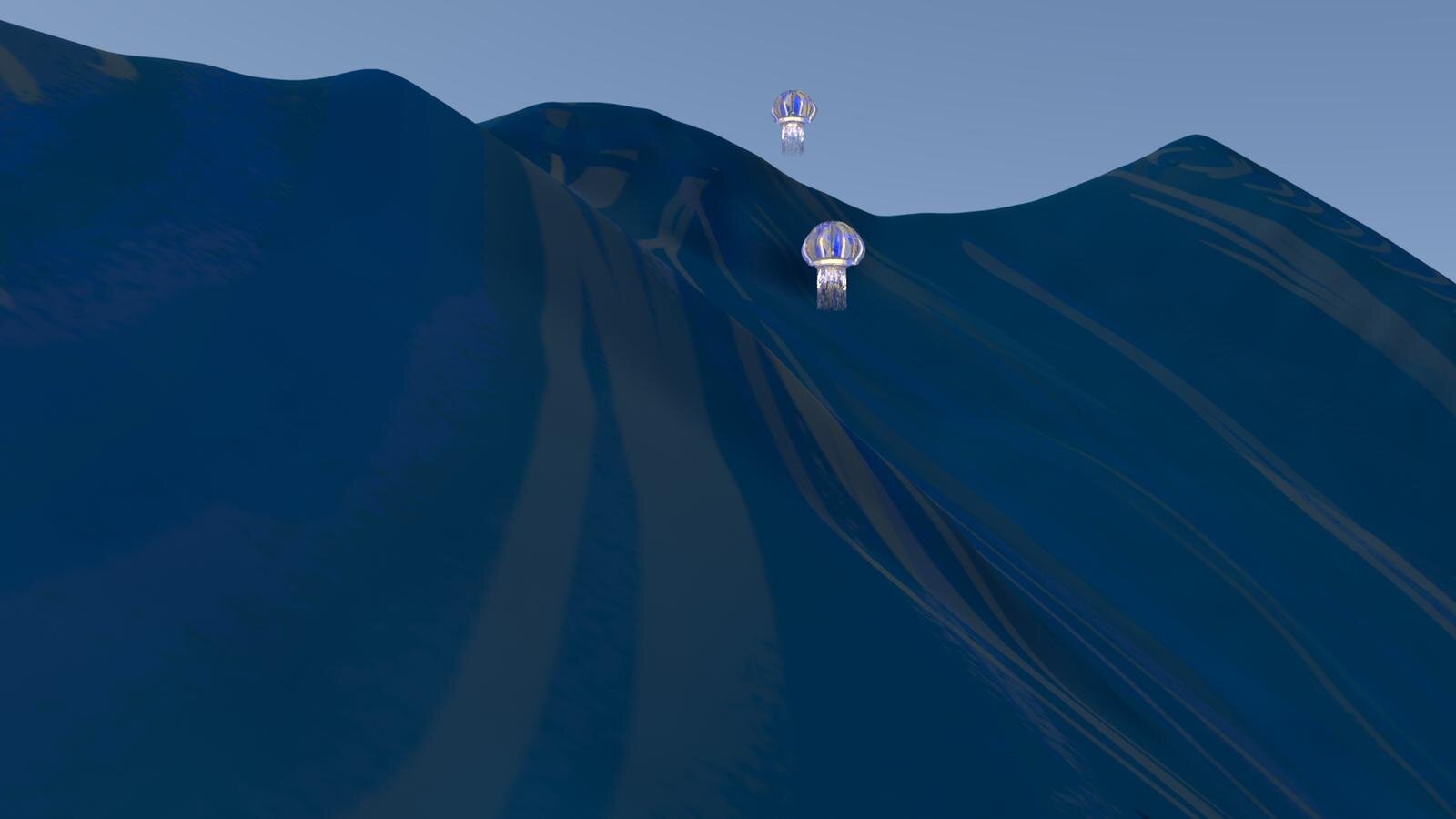

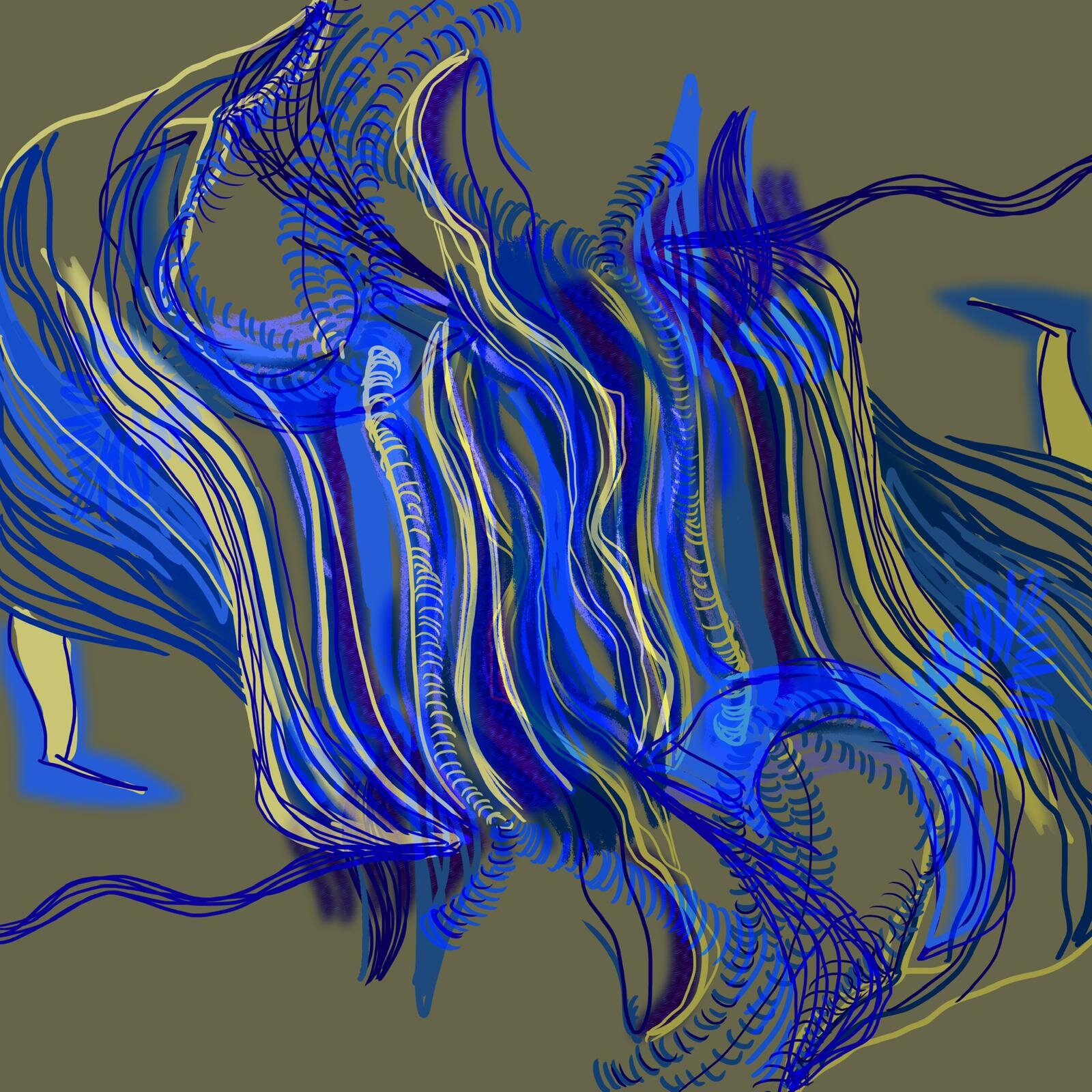
PLASTIC BAGS
“This work is a series of 3D Renders of plastic bag. What I really enjoy about this piece s the ambiguity of the medium. It is not easy to determine whether it is a photo or a 3D render. For most audiences who are no exposed to 3D some of the photos could be real. Through this work I am referencing the climate crises that affects us. The reason I chose plastic bags as the subject for this still life is because I love the texture and organic nature of a plastic bag. I believe plastic bags are quite beautiful and have in mind to start a plastic bag collection”
As most plastic is not getting recycled – AI Robots could be the solution. A question we would therefore like to reflect on is how artificial intelligence will help recycling become more circular?



Ai-Da
Ai-Da is the world’s first ultra-realistic AI artist robot. She has reached international fame through her ground-breaking first show at the University of Oxford in the summer 2019. She was described by New York Times as “a new voice to the art world”, and spent the
rest of the year traveling internationally. “She is the latest AI innovation to blur the boundary between machine and artist: a vision future suddenly becoming part of our present” Times Magazine, 2019
Ai-Da is a humanoid robot, with Artificially Intelligent capabilities. Ai-Da can draw and is a performance artist. As a machine her artist persona is the artwork alongside with her drawings, performance art, painting and sculptures. In the time of online avatars, AI chatbots, Alexa and Siri, Ai-Da as a robotic artist is acutely relevant. Neither human or conscious, she is an artist robot designed to get us thinking about who we are, what we might become, and what we might like (or not like) that to be. She is not alive, but she is an entity that we relate and respond to. She helps us question the nature of art, creativity, and consciousness.
Painting: Ai-Da’s drawings are the start of a painting sequence that involves humanoid, AI Neural Networks and traditional oil painting techniques.The process of her drawing involves the formation of co-ordinates for the robot’s hand to follow. AI researcher Aidan Gomez has created a program which produces a highly detailed and intricate response. The Shattered Space artworks are the visual result of the neural network’s response to data. Lightness, colour and form are all decided by this response.
“The total process of the artwork creation is illuminative: layers of abstraction and concealment by both machine and human forces distort the original image indicating an increasingly technological world where truth and reality are hard to pinpoint and easy to obscure”
Drawings: Ai-Da drawing ability and artificial arm was programmed by Salaheldin EL Abd and Ziad Abass. They developed many sets of AI Algorithms, in which pixel coordinates are turned into real space coordinates. The AI Algorithms and artificial arm allow the drawing algorithm outputs to become a physical reality. Ai-Da is able to draw through cameras in her eyes and with her memory storage. She then runs through her AI programs to create a drawing.Ai-Da’s drawing style is not representational and follows on from art historical developments in the twentieth century. Her fragmented style reflects concerns over the potential for depersonalisation in the future with the rapid growth of technology. The faces she draws are expressive and jagged. They remind humanity that we should be cautious and thoughtful when implementing technologies that impact our future.
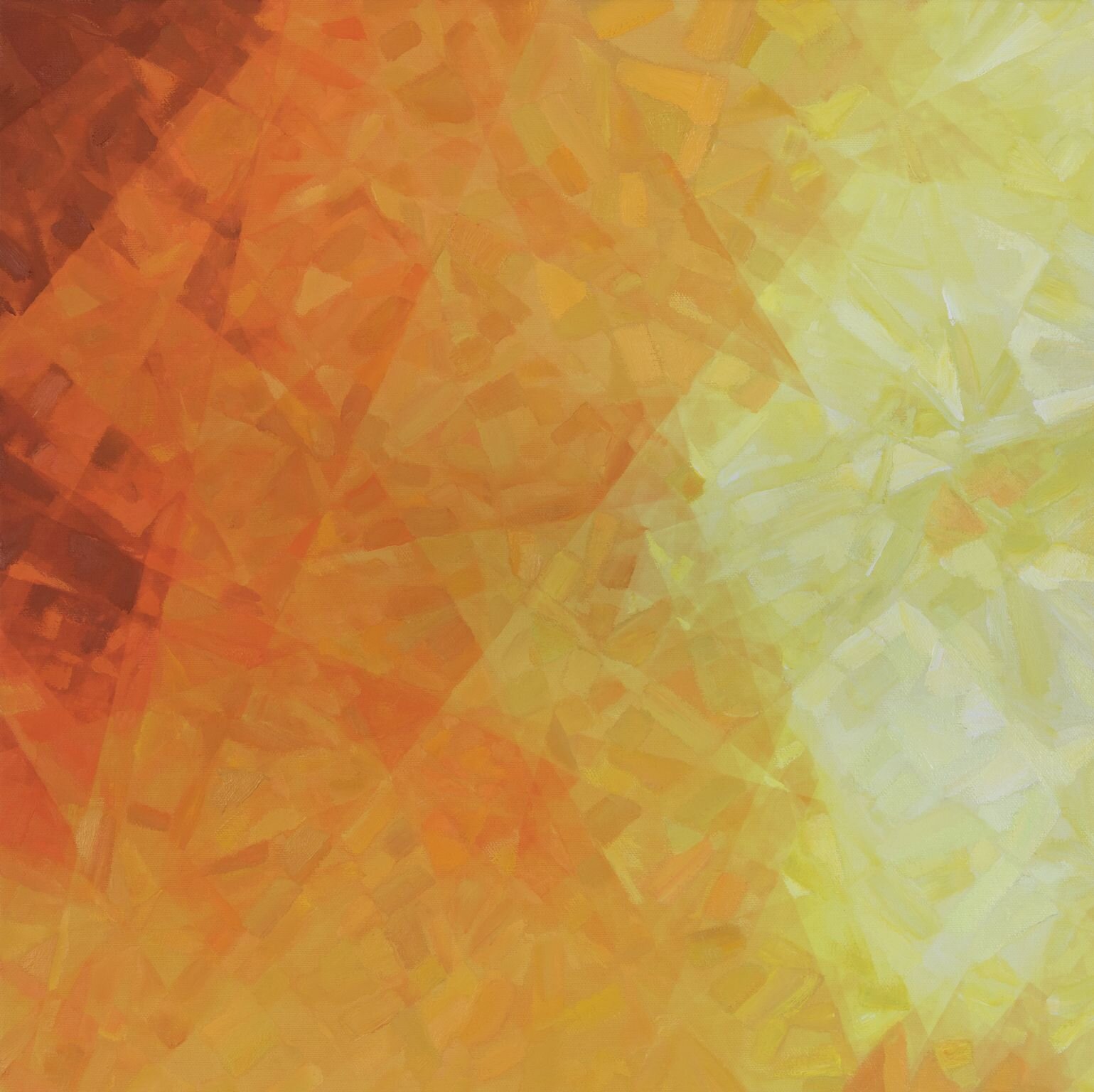

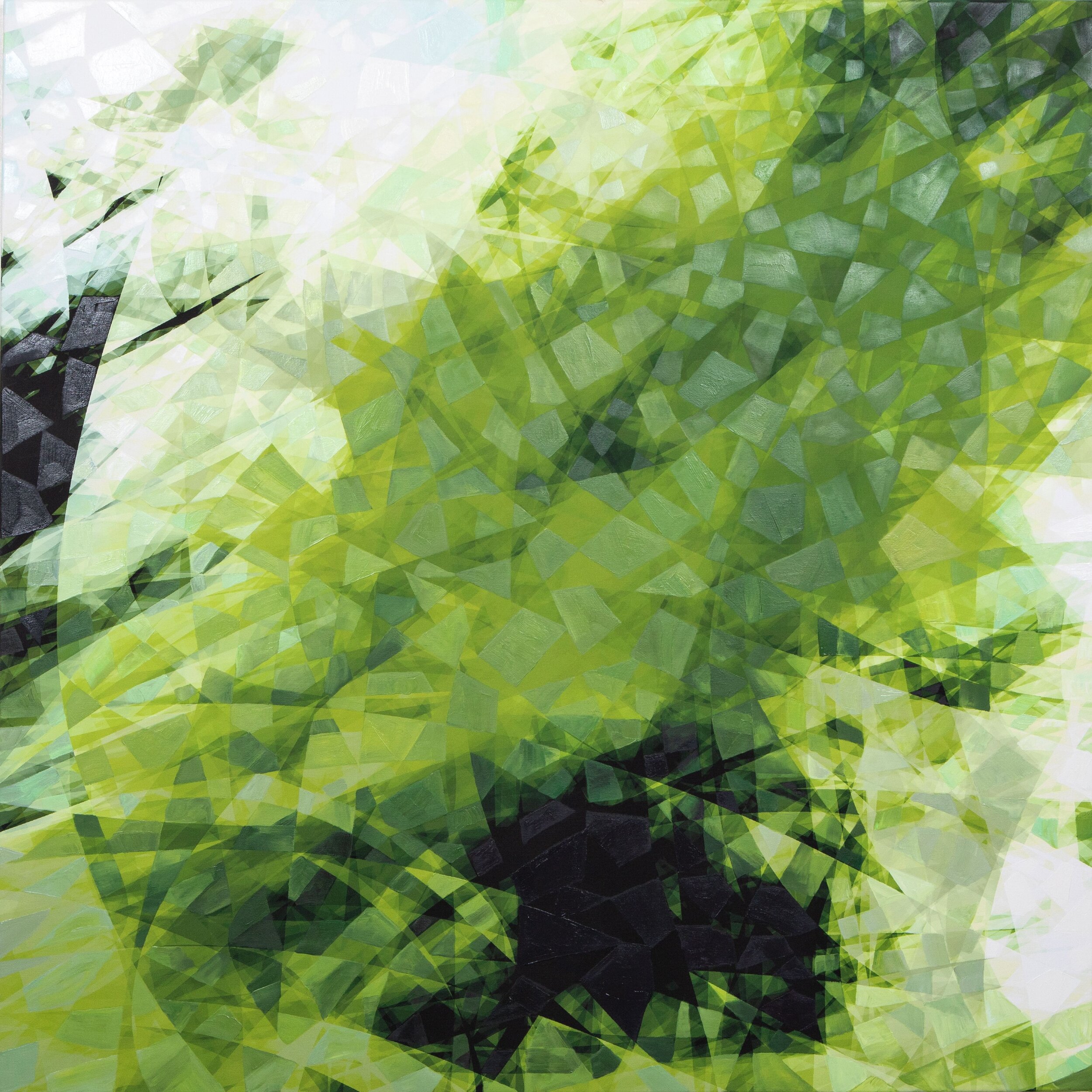
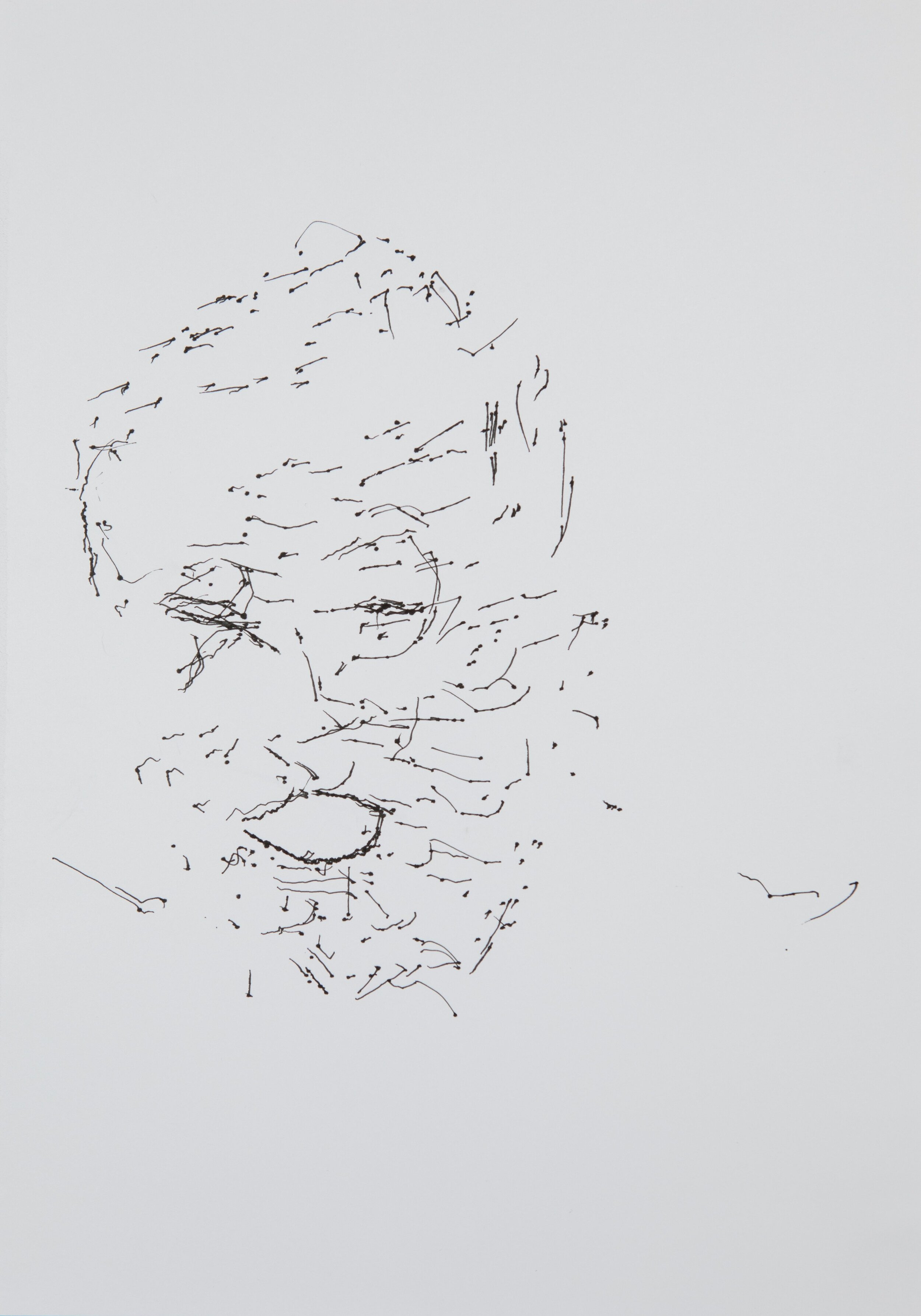
Ai-Da Performance Art at the University of Oxford, May 2019
Audience members were invited to ‘clothe’ Ai-Da by adding a piece of recycled fabric to Ai-Da’s robotic body. 'Privacy' explores issues of technological invisibility and concealment. It is an homage to Yoko Ono’s, ‘Cut Piece’, 1964.
“I hope that art will continue to comment and engage with technological developments, and the ethics of their use. For instance, my recent collaboration with The Tate Exchange and a Vibe Called Tech explored the role of technology as both a tool of empowerment and oppression, and reassessed the relationship between technology, race, and creative endeavour.
Contemporary art has an important role in helping us reimagine our worlds, and holds the ability to reflect aspects of our lives back to us in new ways. I think the warnings of George Orwell’s ‘1984‘ and Aldous Huxley’s ‘Brave New World‘ are still relevant to us today, and I hope art continues to inspire people to think carefully about our future. As for further robot artists, I will be intrigued to see and interact with them!”
Ai-Da
If you would like to find out more information about our AI participants please email: ines@theartsphere.co.uk




































